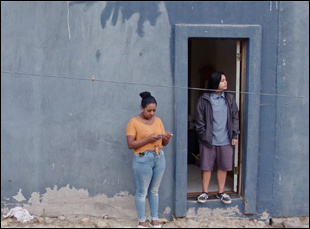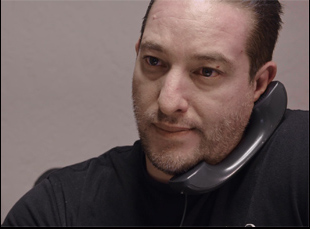“That’s why we came here — to live that straight American Dream,” Jenna says rather ruefully in “Call Center Blues,” sitting in a house in the middle of Tijuana, Mexico, where she’s followed her girlfriend Alondra from living on the streets in Buena Park, California. “What am I going to work at McDonald’s and not be able to pay rent and not be able to have a family?”
The two made the choice to head down south to Mexico, but it could be argued they didn’t have much of one after Alondra’s mother was deported from America years earlier, leading to a chain of events that would ultimately put her daughter and her girlfriend of three years in such dire straits. However, across the border, the two found stability they could not in the U.S., just one story of many in Geeta Gandbhir’s compelling new documentary that upends notions about the hundreds of thousands who have been forced out of the lives they established stateside as radically as her subjects have had to readjust to their new set of circumstances.
In Tijuana, Gandbhir finds a collection of interesting characters at the curious waystation provided by telemarketing call centers that offer steady employment with no questions asked, giving those with uncertain immigration status, criminal records or other information they’d be fearful of making it into the system a place to earn a modest income. For one of her subjects, Roberto, whose family brought him to the U.S. when he was six and worked his way up to become a manager at LAX, this new job is most certainly a come down from his previous life, while for Danny, who was deported after being arrested for trafficking, the job offers honest work that would no doubt prove elusive to him in the country he grew up, only reminded of his limitations by the fact that he can no longer visit the rest of the his family.
By bringing what’s missing from their new lives to the surface, “Call Center Blues” offers up as complete a picture as possible of these uncertain times for both its subjects and the countries they exist between without really feeling a part of either, and Gandbhir elegantly lays out a situation that’s anything but for those living it. With the 24-minute short recently made available to stream online after its intended premiere at SXSW was cancelled as a result of the COVID-19 outbreak, the director graciously took the time to speak how she became interested in what’s going on at the border, how prioritizing local representation on the crew helped enrich the filmmaking, and capturing the atmosphere right now in Tijuana.

I’m going to give credit where credit is due. I read an article in the New York Times that spoke about the aftermath of so many people being deported, talking about these call centers that were springing up opportunistically in Tijuana and [because] this is a community that speaks English, they were uniquely desired by the call centers [which] I thought was fascinating. The number of people that have been deported was so great that these folks who had lived most of their lives in the U.S. and were shipped off to places to Tijuana were forming their own communities [through places such as] English-speaking churches and community centers, trying to stay together and support each other, which shows tremendous resilience.
We heard stories of addiction and homelessness and struggle, and what was interesting is that the call centers had become almost like a survival mechanism in these folks’ lives, [which is] something you never hear about. A lot of times you’ll hear about people being deported, but what happens on the other side, particularly long term is not really covered. Often times the first thing they do is try to return to the U.S. and maybe they’ll attempt to cross again multiple times, but is there a point where they’ll stop, and then there is a point where they have to figure out their life in the situation they’re in and I don’t think that’s a story we hear anything about. It raised a lot of questions for me of migration, about the definition of home and a love for a country that obviously doesn’t return that love, and the idea that after so long, and often times creating families or rebuilding lives, that sense of displacement remains.
It’s very ambitious for a short film since you don’t often see multi-stranded narratives like this, given the condensed timeframe. Was that always the approach?
It was important for us to have different perspectives, because even though the stories all overlap in some ways, there’s still diversity and we wanted to showcase as many voices as we could. An interesting find was Alondra and Jenna because they had migrated to Tijuana following Alondra’s mother who had been deported, so their story to me seemed less obvious perhaps than someone who was deported themselves, but [there] was this ripple effect. Alondra’s life is filled with homelessness because of her mother’s deportation, because once her mother was deported, she was left with her grandmother who couldn’t provide for her and the other kids that she was taking care of and the effect of removing a key family member from a family affects generations.
We had an amazing producer Abraham Ávila on the ground in Tijuana, and he was really key in finding people because it was really, really important for us to engage local folks to bring authenticity to this story. I studied in Mexico when I was younger and I do speak Spanish, but it was not my community, so it was very important to me and to Multitude Films and to Topic to make sure we had representation in our team and we wanted a producing partner who would have equal say in the process of the filmmaking. Abraham worked with us to find all the characters and we talked to him about what we might be looking for and he went out and met people, gained some trust, and convinced them to participate.

Obviously, our characters determined a lot of the places that we filmed because through their stories we wanted to showcase how Tijuana felt to them and they pointed out the places that mattered to them. For example, we see in the film there are some shots of the river that runs through Tijuana, [where] there’s often a lack of water, and for a lot of people, when they’re first deported, that river is unfortunately a place where they end up when they’re struggling with drug addiction and homelessness, so we wanted to showcase that as a place. That was actually a place Roberto ended up being a lot of the time because he had spiraled into addiction, and Danny talked about it [too]. He pointed out to us people literally walk right across the border, which is right near his office, so I think some of [the feeling] was based on that and some of it was based on the wall.
The wall was also incredibly ever-present everywhere we went, so it was important to showcase that, but really, this border seems almost ridiculous because the cultures and the people crossing back and forth, who are interdependent, between Tijuana and the U.S. on the other side, with California, [make it feel] superfluous. While we were there, Trump was constantly shutting down the wall and there was all this false news about the migrant caravan as he was wrongly referring to it and to be on the other side and to see that perspective was really powerful. We learned so much about the one-sided perspective of the U.S. and the U.S. media often blinds those of us who live in the U.S.
Was there anywhere this story took you you weren’t expecting?
What we didn’t realize is the idea that the church was trying to pull people in before the cartels or addiction would claim them. There was this battle, as the pastor in the film tells us, for the deported [where] their safety is at stake because they are being deported to a country they know very little about and have no support system, and I did know about homelessness and addiction, but the idea there was this pressure to try to save people — that’s the way that the church saw it — was surprising to me because I didn’t know about this church community that’s fighting to help people. That was really powerful because you think about everything the deported are dealing with — the trauma of separation and the loss of everything they’ve ever known and then on top of that, the idea that you have these forces tugging at you, trying to get you in.
Then again, [there’s] the call centers themselves, [which even though] they can be a great resource, they’re also opportunistic. They just want people who speak English and if you are addicted to drugs and you show up to work, it doesn’t matter to them. It’s a business in which you don’t necessarily get ahead. It’s cheap labor for the companies, so it’s still exploitation and interestingly, we learned that call centers spring up in Tijuana based on waves of migration, so [when] there was a wave of Haitian migrants who had come through a number of years ago and they were French speaking, there were call centers that pulled them in [for that reason]. So it’s a fascinating blend of commerce, exploitation and warring forces and then crime. These are all things that deportees are faced with.

Of course, we were heartbroken because we had a beautiful festival run lined up, starting with SXSW and we were really excited to premiere at a border state because we were so interested in the audience and how they would respond. It just felt really fitting because these border states face these issues in a way that perhaps those of us up north do not, so the dialogue around the relationship is so important. But at the same time, I feel like we are fortunate that we do have distribution through Topic Film, and they have been incredibly supportive. I also feel like the industry is pulling together in a way that’s really heartening. For example, Oscilloscope and Mailchimp have come together to distribute the shorts from SXSW for 30 days of streaming, so we’re promoting those links on social media and like the rest of the world, we’re now figuring out alternative ways to get the film out there to a wide viewership. We’re hoping through these means we can still be seen while everybody’s stuck at home anyways.
“Call Center Blues” is now streaming here.





Comments 1